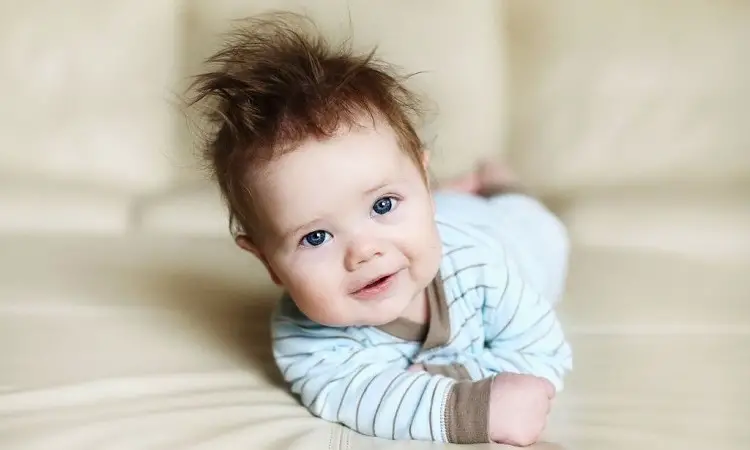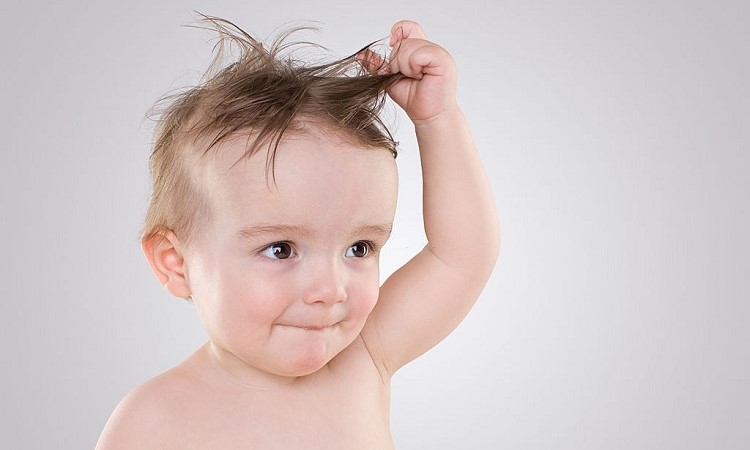Many new parents seem to worry quite a lot about the phenotypic makeup of their babies. You know, the visible characteristics like eye color, complexion, body type, and hair color.
Hair color is one factor that new parents, mothers especially, worry about so much. Some babies could be born with red hair, but as time goes on, their hair color changes to a shade of brown.
This phenomenon is quite common. That is why we’ll dedicate this article to answering the popular question. When do babies hair change color? We’re pretty sure you want to know why too. So, read on and find out why!
When Is The Hair Color of Babies Determined?
Before we answer the question when do babies hair color change, we will first take you through the hair formation process of babies and when their hair colors are determined. Knowing these things will help you understand every other thing better.
Remember in your high school biology class when the teacher said humans are made up of 46 chromosomes? It would interest you that the 46 chromosomes that constitute your genetic makeup are not obtained from one parent alone.
A baby comprises forty-six chromosomes, twenty-three from the mother and twenty-three from the father.
That sums up to forty-six, right? Perfect! That’s how it goes. If you’re curious about what chromosomes are, I’ll tell you.
Chromosomes are the units of inheritance found in the genes. They vary from individual to individual. No two people can have the same type of chromosomes. They can only have similar ones.
Sometimes, you’d see a baby and say the baby looks a lot like its mother. You’d see the father and say the baby looks like its father.
It’s the work of the chromosomes. Babies are made up of the genes of both parents in equal proportions.
Some traits from one parent way overshadow the other. That is where dominance comes to play. The trait that is greatly expressed is the dominant one, while the one that is overshadowed is called the recessive one.
Now, let us critically look at this baby’s hair color. For example, a mother has jet-black hair. The father has brown hair. From this combination, a lot of things can happen.
The child can inherit the black hair of its mother; it could also inherit the brown hair of its father. The child could even inherit both. You know, a mixture of black and brown.
In some cases, the child might have a different hair color entirely. Genetics and inheritance run deep.
So, when you worry about your baby’s hair color, you should keep in mind that genetics is a very broad thing and that your expectations won’t be met all the time.
You should also note that the baby’s hair color is determined in the womb. Yes, even before the baby is born, it has a set hair color. If your baby has brown hair, it was determined in the womb already.
We know this might confuse you, so we’ll break it down. The whole chromosome thing happens in the womb.
So, no real change can take place after conception. There are exceptions to this, and mutation is a perfect example of such an exception.
When Do Babies Hair Change Color?

Now, we’re back to answer your question. When do babies hair color change? Hair color changes in babies are very natural phenomena.
It would interest you to know that in almost all cases, the colors of the babies’ hair change to later on be the original color.
Although this hair color change occurs frequently, its exact time has not been determined.
You know, there are always fluctuations. Some babies’ hair color changes quite early; others take longer to change.
But, most babies’ hair colors change between six and nine months. This doesn’t mean your baby’s hair might change at this point. Your babies could happen earlier or later. This is just an average.
Also, there’s the possibility of your baby’s hair not changing at all. You should also keep this in mind.
Read: How To Tell If Baby Has Hair On 3D Ultrasound
What Makes A Babies Hair Color Change?
Babies’ hair colors are susceptible to a lot of changes. This is one thing that you should note.
A baby might be born with particular hair color, but as time goes on, that color morphs into another color. For example, a baby could be born with deeply colored brown hair.
But at later stages of the baby’s life, the baby’s hair changes to a very light shade of brown. A couple of factors can also influence this change.
When asking the question of when do babies’ hair changes color? you should also note these factors. Find them below.
- Environmental Changes: The weather influences a lot of things. Even hair color. Some hair colors may begin to appear lighter or darker at different points in time.
- Products: A lot of hair color changes are often attributed to products. No, we’re not talking about dyes. We’re talking about true hair color changes caused by hair products. You know, many hair products contain various degrees of chemicals that can tamper with hair color. If you’re very keen on maintaining your baby’s hair color, you must be very careful of the products you use.
- Hormones: Hormones can also influence changes in hair color.
Could My Child’s Hair Color Change?
The answer is yes! Since the amount and nature of pigment are already embedded into your child’s DNA, it’s still developing. This can go on until they are 6-7 years old.
A child’s hair color can significantly change over several years. Due to the pigment, its density and distribution are still adjusting and “settling” in.
One scientific research revealed that people of European descent are usually prone to hair color change.
Scientists are still unsure why this is so and how. But many believe it results from hormonal changes, activating the melanin in the hair follicles.
A typical study found that most kids with blond hair grew up to have darker locks when they hit their teenage years or puberty.
Unique Hair Color
If you’ve ever goggled through the web for “unique baby hair color,” chances are that you will come across some pretty wild results.
Certain conditions, caused by what medical experts call loss of function, that cause variation in color.
1. Poliosis
Poliosis is, also known as “white forelock” is a condition where a particular spot of hair is white.
Looking closer at this phenomenon, medical experts concluded that the hair follicles in that spot lack melanin.
While the rest of the hair, however, is a natural color, either brown or black. This makes for a very particular appearance.
As you may know, poliosis occurs when several genetic syndromes occur simultaneously. These syndromes include tuberous sclerosis, piebaldism, and Waardenburg syndrome.
Medical experts have concluded that it can occur due to a series of acquired conditions.
These conditions include inflammatory illnesses, medications, or benign skin tumors.
In some babies, poliosis can also affect other parts of the human body, like eyebrows or eyelashes. Even though this may sound serious, most people with it are perfectly healthy.
2. Albinism
Albinism is generally a genetic condition resulting from the absence of melanin in the hair, skin, and eyes.
People with this condition are often known to have very fair skin and white hair. However, there are so many variations.
Albinism is very common, especially in other countries worldwide. As many as one in 3,000 babies are born with it. This condition affects about one in 15,000 to 20,000 people in the United States.
As you may know, albinism is not a condition your baby can inherit after delivery because it occurs due to a mutation in the genes. The possibility of your baby having it is quite slim.
Typically, for a baby to be born with albinism, both parents must carry the mutated gene. However, research has shown that there is another variation where the mother is the carrier. This type usually only affects the XY chromosome.
Albinism is not malignant, but it can cause poor vision for the person with it. Fortunately, as time goes on, this condition can be corrected.
It is important to note that kids with albinism must always be protected from the sun. This is because their sensitive skin lacks pigmentation and can easily become sunburnt.
It is very important to apply sunscreen creams and dress them in non-transparent clothing, including hats and loose shirts.
It’s not unusual for some parents to be concerned about whether or not they will have a child with albinism. If it worries you, do not hesitate to speak with your doctor.
Related Posts:
- When Do Babies Get Eyebrows
- When Should Babies Start Wearing Hard-Bottom Shoes
- How To Stop Babies From Pulling and Eating Their Hair
- How Soon Can a Baby Recognize His Parents
- How To Tell If Baby Will Be Right Or Left-Handed (6 Helpful Signs)
Conclusion
When do babies hair change color? We believe that this article has been able to broaden your enlightenment about babies and hair color changes.
You don’t have to worry anymore about when babies’ hair color changes. Isn’t that awesome? Now, go forth and bask in your new knowledge.
